Benching the GeForce GTX 1080 Ti: Air vs. Liquid Cooling
Introduction

Here at TBG, we love to push video cards to the limit, and at a certain point, that means you end up overpowering standard cooling setups. As enthusiasts, we wondered whether liquid cooling a GPU can provide as many, or perhaps more, benefits than liquid cooling a CPU. We’ve certainly explored CPU cooling in the past, and because we’ve seen high-end video cards use ever-increasing amounts of power over the years, we decided it was time to liquid cool one to see whether we could push performance to the next level. To do so, we purchased two EVGA GeForce GTX 1080 Ti Founders Edition cards at retail, and then upgraded one with an EVGA Hybrid liquid cooler to put the two cards to the test. We’ve previously benched our two cards running at 4K running in SLI, so you might want to check out that article if you’re interested in SLI, although we’ll be touching upon that briefly in this article as well.
The product we have on the bench today is the EVGA GeForce GTX 1080 Ti Hybrid Cooler, part number 400-HY-5388-B1. Truth be told, we decided a few months ago not to bench this product at all, because EVGA discontinued it only a week after its introduction. Had we known EVGA would discontinue the cooler, we certainly would not have paid $160 at retail for it, as we’re not in the business of reviewing phantom products. Furthermore, the GTX 1080 Founders Edition has also been unofficially discontinued, so we got doubly-burned here. But due to the numerous requests we received from viewers of our YouTube review of the cooler, we’ve decided to go ahead with this benchmarking article in the “interest of science.” And in reality, EVGA has replaced the cooler we tested with a very similar product, its Hybrid SC cooler, part number 400-HY-5598-B1, which has the added benefit of working on a wide range of EVGA’s GTX 1080 Ti cards, not just the Founders Edition. Furthermore, EVGA now sells its complete EVGA GeForce GTX 1080 Ti SC2 Hybrid Gaming Video card, so there’s still plenty we can all learn about liquid cooling to make the time invested in this article worthwhile. To eliminate any chance of bias, we purchase all of our video card samples at retail. If you decide to purchase either of these products after reading this review, we’d really appreciate if you use the links we provide in this article to help us recoup some of the costs associated with producing this review!
Test Setup
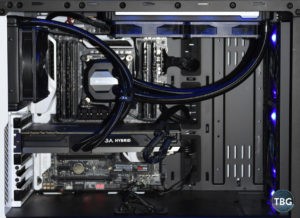
Here are the specs of the system we used for benchmarking:
- CPU: Intel Core i7-6900K, overclocked to 4.2GHz
- Motherboard: Asus X99-Pro/USB3.1
- Video Cards: 2x EVGA GeForce GTX 1080 Ti 11GB Founders Edition
- Liquid Cooler: EVGA GTX 1080 Ti Hybrid Cooler, #400-HY-5388-B1
- SLI Bridge: EVGA High-Bandwidth SLI Bridge 1-Slot
- RAM: Corsair 4x8GB Vengeance LPX DDR4-3200
- SSD #1: Samsung 950 Pro M.2 512GB
- SSD #2: Samsung 850 Evo 1TB
- Case: SilverStone Primera PM01
- Power Supply: EVGA Supernova 1000 PS
- CPU Cooler: Corsair Hydro H100i v2
- Operating System: Windows 10
- Monitor: LG 27UD68-P 27-Inch 4K
Above you can see a photo of the Hybrid card in our system. To learn more about how to actually modify your card with a Hybrid cooler, please check out our Founders Edition disassembly video and especially our Hybrid cooler installation video, which we’ve embedded below for your convenience:
Below you can see a photo of our standard Founders Edition card installed in our benchmarking system. The most obvious difference is the lack of hoses protruding from the side, but there are other differences as well. Because the Hybrid card uses a 120mm radiator and fan, it displaces an existing exhaust fan in our case. The Founders Edition allows us to stick with the standard 140mm exhaust fan that our case had pre-installed, which means that overall system cooling may in fact be better in a stock configuration.
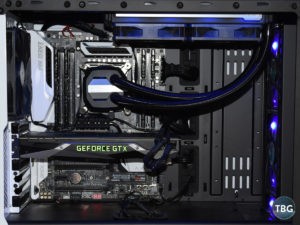
To eliminate system bottlenecks as much as possible, we used our X99-based benchmarking system, which features an Intel Core i7-6900K processor was overclocked to 4.2GHz. For our testing, we’re using one synthetic benchmark and two games, all running at a native 4K resolution: 3DMark Fire Strike Ultra, The Witcher 3, and Rise of the Tomb Raider. The goal of this article was just to discern what effect a cooler has on stock and overclocked performance, and to do so we only needed to run a few game benchmarks. All game data was collected in actual in-game runs, which often provide totally different (and obviously more relevant) results than canned benchmarks. We used FRAPS to collect data for three 30-second samples of each benchmark on each video card setup.
To really push our coolers, we overclocked them to their maximum potential, and we also collected temperature, noise, and power measurements. Remember, our two test samples are both using GTX 1080 Ti GPUs, so a lot of the differences are going to be seen outside of frames/second measurements, as we’ll show shortly.
OK, time to move on to the results!
Overclocking, Temperature, Noise & Power Use
Let’s get one major truth out of the way right from the start: the success or failure of overclocking video cards has a whole lot more to do with luck of the draw, also known as the “silicon lottery”, then it does the design of a card’s circuit board and cooler. Yes, you can read all about the huge number of power phases and massive thermal capacity of coolers, but with its current GPUs, Nvidia has pushed the art of fine-tuning to the limit, such that there’s just not a lot of overclocking headroom left on the table. That’s great for gamers, but maybe a bit of a letdown for overclocking enthusiasts. The reality is that most Pascal-based GPUs will achieve an overclock of 10-13%, depending on the quality of the GPU, not the quality of the cooler or circuit board.
So, with that said, let’s get to the numbers. We had two reference-based GTX 1080 Ti Founders Edition cards, and both maxed out around +160MHz on the core and +800MHz on the memory. What this translates to in games is 2000MHz on the core and 11,800MHz on the memory, at least nominally. In reality, the core clock is heavily impacted by temperatures and power limits, so when people brag about the overclock they can hit, they’re talking about something they’ll never see in a game for more than a few seconds. Our reference cards clocked at “2000MHz” actually averaged about 1924MHz in games, because they hit the thermal throttle point almost immediately.
The good news is that our Hybrid cooler was able to unleash a whole lot more headroom in our overclocks. While adding additional voltage did not provide any additional headroom, we were able to get all the way up to +175MHz on the core, just due to the lower leakage offered by lower temperatures. And much more importantly, with the Hybrid cooler attached, our GPU simply stopped thermal throttling. In games, our 2012MHz overclock actually ran at 2000-2012MHz, limited only by power. Even maxed out at the 120% power limit allowed by Nvidia, this overclock did indeed hit a throttling point, and it had nothing at all to do with temperatures. Let’s look at some of the data we collected to get to provide a bit more perspective on overclocking.
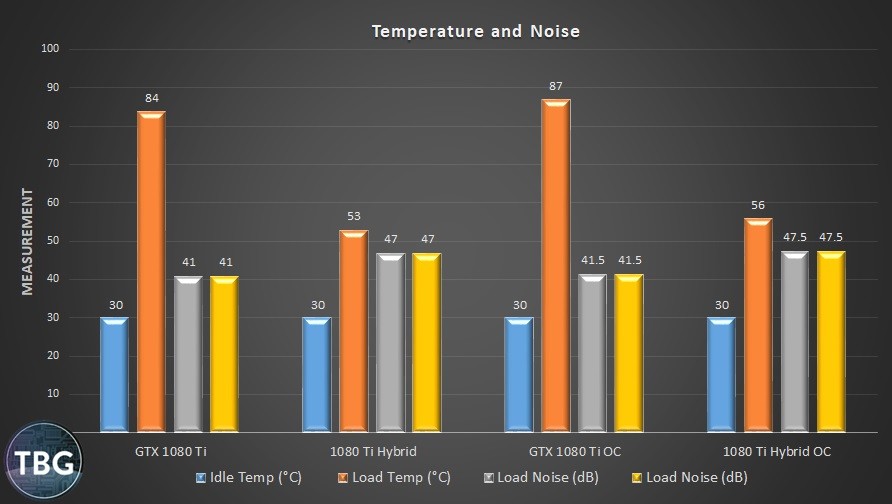
For many GPU enthusiasts, the graph above may be all that needs to be said on the subject of GPU cooling. Our load test used The Witcher 3, and even with a big overclock, our GTX 1080 Ti with a Hybrid cooler attached hit just 56 °C, compared to the 87 °C the reference card hit. Note that this is with the thermal and power limits lifted as high as they would go using the MSI Afterburner utility (90 °C and 120%, respectively). Our non-OC numbers were gathered using zero tweaking, which means both power and temperature limits were in full effect. That’s why the reference GTX 1080 Ti only hits 84 °C, the limit imposed by Nvidia.
There’s just one fly in the ointment, and that’s noise. The EVGA Hybrid cooler is incredibly loud, easily drowning out the noise generated by our dual-120mm Corsair Hydro CPU Cooler. While pump noise is usually the main problem when it comes to liquid cooling, in this case it’s the 120mm fan supplied by EVGA. It starts at a buzzy 1,100RPM and just goes up from there. It’s shockingly-loud, really. We actually performed some testing using a high-end Scythe cooler locked at 1,200RPM, and we found that idle noise dropped to just over 40dB, which is a whole lot more acceptable. Yes, load temperatures went up a bit, but in our opinion, that’s a fine tradeoff. Any enthusiasts looking to GPU liquid cooling to tame the noise from their systems will absolutely need to switch out the fan supplied by EVGA. Note that it has an ultra-short custom power lead, so it can’t even be hooked up to a motherboard for more fine-grained user control.

In contrast to our temperature and noise numbers, there’s relatively little to say about power. We were actually very impressed that the Hybrid cooler didn’t negatively affect idle power use, and in fact seemed to have an overall positive effect on load power use, coming in just slightly below the Founders Edition in nearly all our gaming runs. This is particularly impressive in the context of our OC numbers, as the GTX 1080 Ti with the Hybrid cooler not only hit a slightly higher nominal overclock, it also ran about 75MHz due to the total absence of thermal throttling. In other words, you’re getting a faster result despite the same or lower power use. Very cool!
Performance Benchmarks
With the context provided on the previous page regarding overclocking, temperatures, and noise, let’s look at some cold, hard benchmarks.
3DMark FireStrike Ultra
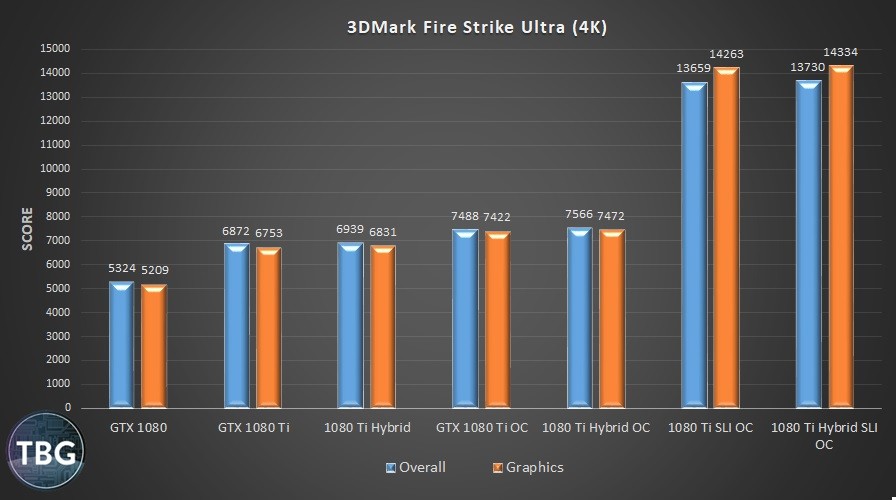
We’re including the GTX 1080 in our benchmarks for the benefit of owners of that card considering an upgrade, and for 3DMark, we also tested our cards in SLI. We’ll save the discussion of SLI until the next page, so we’ll focus on the 1080 Ti in our remarks here. As can be seen, the Hybrid card is indeed faster than the Founders Edition card at both stock and OC settings. And consider for a moment that at stock settings, these two cards are in fact running at the same “base clock,” and both are also heavily-limited by the 100% power limit in place. Nonetheless, the Hybrid model pulls ahead by over 1% in the 3DMark FireStrike Ultra Graphics Score (the orange bars). This delta comes down entirely to thermal throttling, or the lack thereof. In 3DMark, we saw our FE card running at around 1759MHz stock, while the Hybrid card hit 1848MHz stock. Remember, folks, these using the exact same base and boost clocks. One is just running being throttled, while the other isn’t.
The Witcher 3

We see even more difference in The Witcher 3, in part because being an in-game run, the GPUs heated up more than in the short benchmarking scenes of 3DMark. Our GPUs ran for about 10 minutes in our real-world runs, and what we found was that the Hybrid card was an impressive 2% faster than the FE card at the exact same stock settings. This is a pure case of thermal throttling, because our reference card got stuck at 84 °C, meaning it just couldn’t get anywhere near its maximum boost. Once overclocked, the difference drops to 1%. Keep in mind that the Hybrid card overclocked to 2012MHz, just 12MHz faster than the FE card, which means that the 1% delta is again due to temperatures. It would have been larger if we hadn’t allowed the FE card to bypass the 84 °C. It was still thermal throttling somewhat at the 87 °C it hit when overclocked, but voltage wasn’t reduced as dramatically as it was with the stock 84 °C limit in place.
Rise of the Tomb Raider

Here we see the most impressive gains provided by the Hybrid cooler. At fully stock settings, the Hybrid card is 3% faster, simply because it’s able to run at its maximum stock boost, unlike the FE card. Once overclocked, the cards are separated by just over 1%, with the FE card benefitting more from overclocking because it’s constrained by both temperature and power limits at stock settings, whereas the Hybrid card is constrained only by power limits.
SLI Testing
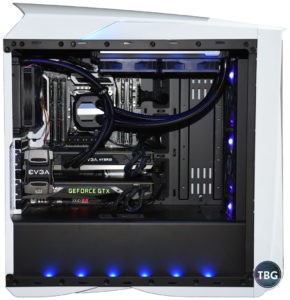
As we’ve seen, if you’re willing to run your card at high temperatures, you don’t really need a liquid cooler. But things get more complicated when running two cards in SLI. As we found during our testing of dual GTX 1080 Ti Founders Edition cards in SLI, the top card in this type of setup ends up in thermal runaway, as the FE cooler just can’t contend with both the heat of the GPU it’s cooling as well as the ambient heat created by another hot running card below it.
We’re going to discuss just one quick bench here, the 3DMark results that we provided previously. In terms of absolute numbers, our results aren’t that impressive, but consider that because our lower FE card could only hit +160MHz on the core, we limited our top Hybrid card to that as well. And that lower card was still throttling pretty badly, as it ran well above 75 °C in this test.
As shown below, our overclocked SLI setup was about 0.5% faster using a Hybrid cooler on the top card. More importantly, for long-term gaming (think many hours spent gaming, rather than a few minutes spent benchmarking), thermal throttling will be kept at bay. We informally tested a number of games, and at our overclocked settings, both cards stayed below the temperature of a single FE card on its own. In our previous GTX 1080 Ti SLI article, we found that running dual FE cards results in noise levels topping 50dB, which frankly was just too loud! What we ultimately decided to do with this SLI system was to run a Scythe fan fixed at 1200RPM on our Hybrid’s radiator, which allowed temperatures to creep up to 62 °C, but greatly limited noise output. Our SLI system maxed out in Battlefield 1 produced just 45dB, compared to the 47dB the single GTX 1080 Ti Hybrid produced on its own with the stock EVGA fan. This is the ultimate gamer’s setup: faster and quieter than dual FE cards, with slightly lower power use to boot!

While we haven’t included them here, our SLI benchmarks of The Witcher 3 and Rise of the Tomb Raider exhibited similar deltas between two FE cards and a combo of a Hybrid and FE card. In other words, the benches themselves aren’t that compelling, but the reduction in temperatures, and more importantly noise, definitely were!
Conclusion
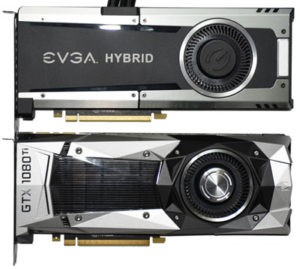
As we’ve seen in our tests of CPU liquid coolers, the addition of water, hoses, pumps, and radiators doesn’t necessarily translate to a win-win. Liquid coolers, whether used on a CPU or GPU, are harder to install and harder to manage inside a PC, and aren’t even necessarily quieter. But where they really come into their own is when a user wants to push a system to its absolute maximum potential. Yes, you may be chasing the last 1% of performance, but if you’re a die-hard tweaker, getting there is half the fun!
So, for gamers looking to “max out” their GTX 1080 Ti Founders Edition cards, we can absolutely recommend the EVGA Hybrid SC cooler, part number 400-HY-5598-B1, which has replaced the Hybrid cooler we tested for this article. And if you are stepping up to a GTX 1080 Ti for the first time, you should definitely consider the factory-built EVGA GeForce GTX 1080 Ti SC2 Hybrid Gaming.
Remember, to eliminate any chance of bias, we purchase all of our video card samples at retail. If you decide to purchase either of these products after reading this review, we’d really appreciate if you used the links above to help us recoup some of the costs associated with producing this article!
If you’d like to see more content like what’s been covered in this article, check out the Gamer’s Bench section of this site. For our latest video card recommendations, check out our Video Card Buyer’s Guide, or see all of our current PC component recommendations in our Do-It-Yourself PC Buyer’s Guides, which help gamers squeeze every last bit of performance out of their systems, regardless of budget!

